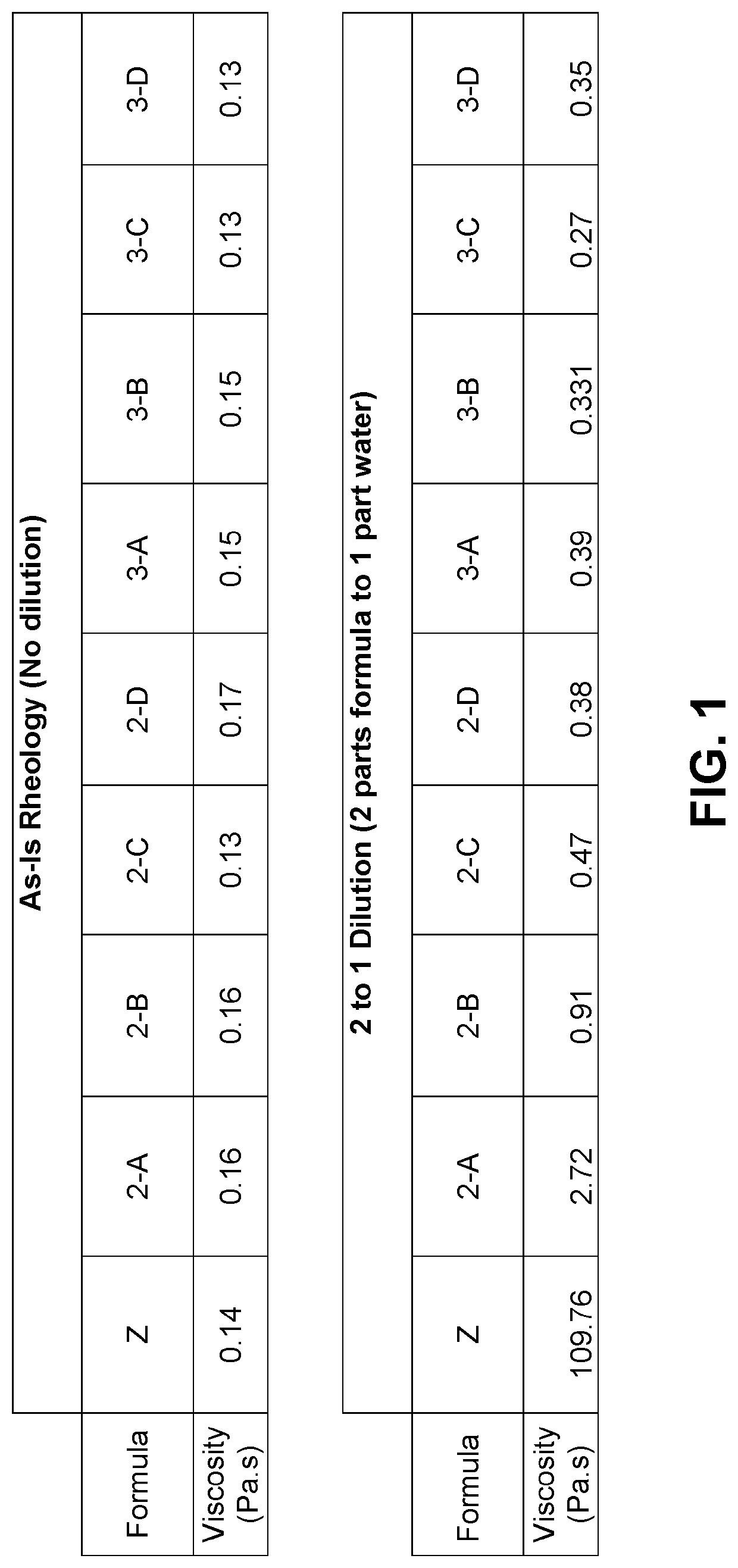Unit Dose Laundry Detergent Compositions Containing Soil Release Polymers
- Summary
- Abstract
- Description
- Claims
- Application Information
AI Technical Summary
Benefits of technology
Problems solved by technology
Method used
Image
Examples
example 1
[0162]The formulations in Table 1 are exemplary of those within the scope of the present disclosure. Similar proportions can be utilized with a free and clear detergent base that does not include fragrance and / or coloring agents.
TABLE 1MaterialFormula Formula Formula Activity1-21-31-4Component%wt. %wt. %wt. %PEG-40010002 to 5 5 to 20Polyethyleneimine801 to 41 to 41 to 4EthoxylateSoil Release60.50.5 to 3.50.5 to 3.50.5 to 3.5PolymerGlycerine99 9 to 13 8 to 13 5 to 15Propylene Glycol99 5 to 10 5 to 100 to 5Alcohol6020 to 2620 to 2617 to 26EthoxysulfateSurfactant 25-3C12-C15 Alcohol10023.123.123.1Ethoxylate 7EOCoconut Oil Fatty100 7 to 10 8 to 101.5 to 4.5AcidWater1005.74 to 8 4 to 122-Phenyl Sulfonic964 to 84 to 8 4 to 12Acid (LAS)Alkanolamine962.2 to 3.52.2 to 3.50.5 to 2.5(Monoethanolamine)Enzymes100.5 to 4 0.5 to 4 0.5 to 4 Fragrance1001 to 31 to 31 to 3Chelant33 0 to 1.5 0 to 1.5 0 to 1.5Optical Brightener100 0 to 0.4 0 to 0.4 0 to 0.4Bittering Agent250.10.10.1Total100100...
example 2
[0163]The liquid detergent formulations in Table 2 were prepared in accordance with standard methods to assess the effect of PEI-EO rheology modifier at various levels. All formulas were free of polyethylene glycol. Formula Z was a comparative formula that did not include either polyethylene glycol or PEI-EO rheology modifiers.
TABLE 2MaterialActivityFormula ZFormula 2-AFormula 2-BFormula 2-CFormula 2-DComponent%wt. %wt. %wt. %wt. %wt. %PEG-40010000000Polyethyleneimine8001234EthoxylateSoil Release60.522222Polymer (watersoluble polyester)Glycerin9913.912.911.910.99.9Propylene Glycol1008.28.28.28.28.2Alcohol602626262626EthoxysulfateSurfactant 25-3C12-C15 Alcohol9923.123.123.123.123.1Ethoxylate 7EOCoconut Oil Fatty1001010101010AcidWater1005.75.75.75.75.72-Phenyl Sulfonic955.05.05.05.05.0Acid (LAS)Alkanolamine993.23.23.23.23.2(Monoethanolamine)Enzymes101.91.91.91.91.9Chelant340.90.90.90.90.9Optical Brightener900.20.20.20.20.2Bittering Agent250.10.10.10.10.1Total100100100100100
example 3
[0164]The liquid detergent formulations in Table 3 were prepared in accordance with standard methods to assess the effect of PEI-EO and polyethylene glycol rheology modifier at various levels. Formula Z was a comparative formula that did not include either polyethylene glycol or PEI-EO rheology modifiers.
TABLE 3MaterialActivityFormula ZFormula 3-AFormula 3-BFormula 3-CFormula 3-DComponent%wt. %wt. %wt. %wt. %wt. %PEG-40010002255Polyethyleneimine8001441EthoxylateSoil Release Polymer60.522222(water solublepolyester)Glycerin9913.910.97.94.97.9Propylene Glycol998.28.28.28.28.2Alcohol Ethoxysulfate602626262626Surfactant 25-3C12-C15 Alcohol10023.123.123.123.123.1Ethoxylate 7EOCoconut Oil Fatty1001010101010AcidWater1005.75.75.75.75.72-Phenyl Sulfonic955.05.05.05.05.0Acid (LAS)Alkanolamine963.23.23.23.23.2(Monoethanolamine)Enzymes101.91.91.91.91.9Chelant340.90.90.90.90.9Optical Brightener900.20.20.20.20.2Bittering Agent250.10.10.10.10.105Total100100100100100
PUM
 Login to View More
Login to View More Abstract
Description
Claims
Application Information
 Login to View More
Login to View More - R&D
- Intellectual Property
- Life Sciences
- Materials
- Tech Scout
- Unparalleled Data Quality
- Higher Quality Content
- 60% Fewer Hallucinations
Browse by: Latest US Patents, China's latest patents, Technical Efficacy Thesaurus, Application Domain, Technology Topic, Popular Technical Reports.
© 2025 PatSnap. All rights reserved.Legal|Privacy policy|Modern Slavery Act Transparency Statement|Sitemap|About US| Contact US: help@patsnap.com



